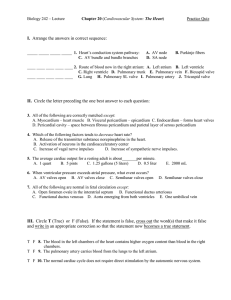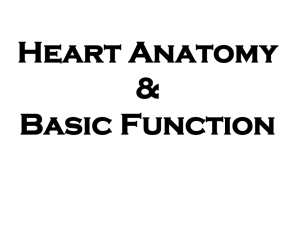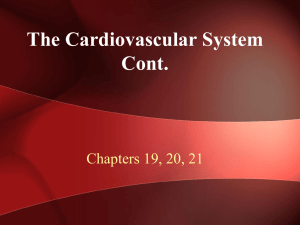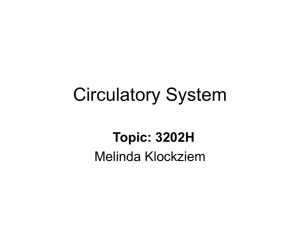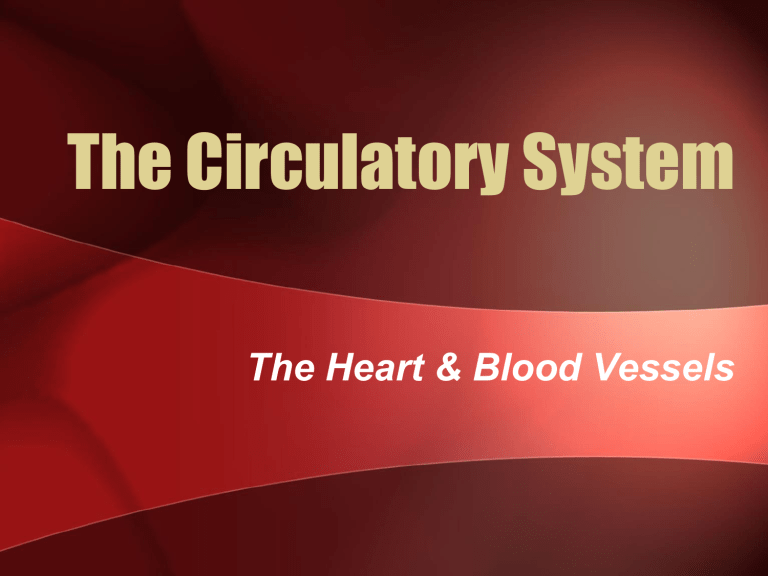
The Circulatory System The Heart & Blood Vessels The Cardiovascular System •Three Major Elements – Blood, Blood Vessels, & Heart 1. The Heart- cardiac muscle tissue –highly interconnected cells –four chambers •Right atrium •Right ventricle •Left atrium •Left ventricle •Superior/Inferior Vena Cava •Right Atrium •Tricuspid Valve •Right Ventricle •Pulmonary Semilunar Valve •Pulmonary Artery •Lungs •Pulmonary Vein •Left Atrium •Bicuspid Valve •Left Ventricle •Aortic Semilunar Valve •Aorta •To the body’s organs & cells Pathway of the blood Circuits •Pulmonary circuit –The blood pathway between the right side of the heart, to the lungs, and back to the left side of the heart. •Systemic circuit –The pathway between the left and right sides of the heart. The Cardiovascular System 2. Blood Vessels -A network of tubes –Arteriesarterioles move away from the heart •Elastic Fibers •Circular Smooth Muscle –Capillaries – where gas exchange takes place. •One cell thick •Serves the Respiratory System –VeinsVenules moves towards the heart •Skeletal Muscles contract to force blood back from legs •One way valves Cardiovascular System The Heart Functions of the Heart • Generating blood pressure • Routing blood – Heart separates pulmonary and systemic circulations • Ensuring one-way blood flow – Heart valves ensure one-way flow • Regulating blood supply – Changes in contraction rate and force match blood delivery to changing metabolic needs Size, Shape, Location of the Heart •Size of a closed fist •Shape –Apex: Blunt rounded point of cone –Base: Flat part at opposite of end of cone •Located in thoracic cavity in mediastinum Heart Cross Section Pericardium Heart Wall • Three layers of tissue – Epicardium: This serous membrane of smooth outer surface of heart – Myocardium: Middle layer composed of cardiac muscle cell and responsibility for heart contracting – Endocardium: Smooth inner surface of heart chambers Heart Wall External Anatomy •Four chambers –2 atria –2 ventricles •Major veins –Superior vena cava –Pulmonary veins •Major arteries –Aorta –Pulmonary trunk External Anatomy Coronary Circulation Heart Valves •Atrioventricular –Tricuspid –Bicuspid or mitral •Semilunar –Aortic –Pulmonary •Prevent blood from flowing back Heart Valves Function of the Heart Valves Blood Flow Through Heart Systemic and Pulmonary Circulation Conducting System of Heart Electrocardiogram • Action potentials through myocardium during cardiac cycle produces electric currents than can be measured • Pattern – P wave • Atria depolarization – QRS complex • Ventricle depolarization • Atria repolarization – T wave: • Ventricle repolarization Cardiac Cycle • Heart is two pumps that work together, right and left half • Repetitive contraction (systole) and relaxation (diastole) of heart chambers • Blood moves through circulatory system from areas of higher to lower pressure. – Contraction of heart produces the pressure Cardiac Cycle Heart Sounds • First heart sound or “lubb” – Atrioventricular valves and surrounding fluid vibrations as valves close at beginning of ventricular systole • Second heart sound or “dupp” – Results from closure of aortic and pulmonary semilunar valves at beginning of ventricular diastole, lasts longer Location of Heart Valves Effects of Aging on the Heart • Gradual changes in heart function, minor under resting condition, more significant during exercise • Hypertrophy of left ventricle • Maximum heart rate decreases • Increased tendency for valves to function abnormally and arrhythmias to occur • Increased oxygen consumption required to pump same amount of blood Cardiac Problems • • • • • Tachycardia: Heart rate in excess of 100bpm Bradycardia: Heart rate less than 60 bpm Arrhythmia: Irregular Heartbeat Murmurs: defects in the valves of the heart Angina: Severe chest pain due to decreased oxygen supply • Myocardial Infarction: lack of blood supply to the myocardium; causes damage to the heart muscle; blood vessels around the heart become blocked with plaque
